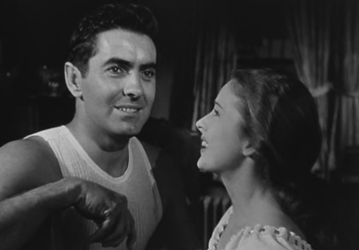
This is film noir at its finest. A sordid story from the dark and shadowy back lots of a 1940s carnival based on down and dirty, strictly adult fare by William Lindsay Gresham in 1946. The novel and its film version are both widely recognized as being at the top of their class.

This is the story of a sideshow psychic, a handsome and talented man who gives the sheriff a cold-reading, protecting his friends from arrest and saving the carnival from being shut down. It is a tale that takes us full-circle with Stanton Carlisle’s rise to the top and, like Icarus, his subsequent fall.
Stan doesn’t start from the bottom, though. There’s a guy even he looks down on: The Geek.

An ordinary geek doesn’t actually eat snakes, just bites off chunks of ’em, chicken heads and rats.” ~Arthur H. Lewis, Carnival
The term carnival “geek” was popularized by Gresham’s novel, but they were a real sideshow act in the old days. The glomming geek was a “wild man” who would bite the heads off snakes, chickens, or rats, and was considered, even by carnies, the lowest of the low.
In the novel, Stanton asks the carnival barker how one manages to find a geek, anyway; is he some half-wit a backwoods family keeps out in back of the barn or something? No, says the carnival boss; you don’t find a geek, you make one. First you approach a hopelessly degraded alcoholic and tell him you want him to pretend to be a geek for a few weeks until you find a real one. (A common dodge is for a person to have a razor concealed in their hand with which they cut the animals they are “biting”.) The carnival operators keep him supplied with liquor until he is utterly dependent on them, and then one day they tell him that the rubes are getting suspicious, so he will have to start actually biting the heads off of the chickens. By then he will already be far down the road of no return.

Stanton scams the secrets of a secret spoken code out of a weathered veteran of the psychic circus, a gorgeous and talented woman named Zeena, who in turn, deeply cares for her partner, Pete– a man who was once on top, but is now a useless rummy. When her partner dies of alcohol poisoning, (having drunk wood alcohol instead of an identical bottle of booze …that Stan just happens to have bought him…) Stanton takes over as Zeena’s partner in her fortune-telling act.
Meanwhile Stanton is taken with the naive, young, and beautiful Molly Cahill, The Electric Girl. After a shotgun wedding that alienates Stan from Zeena, he takes Molly on the road away from the lowly carnival, and begins his climb to fame, secret spoken-code in hand.

Once he’s living big, his old friends from the carnival circuit come to visit… but Zeena’s tarot cards foretell the hanged man, and death. (It is insinuated that this reflects literal death despite the card’s true meaning in tarot readings: a new beginning.)
“Takes one to catch one.”
One of the insights of the movie comes from a subplot involving a psychotherapist named Lilith Ritter. It portrays a therapist as an unethical grifter who records her sessions (unspoken, but evidently for the purpose of blackmail,) while asking allegorically whether an ex-carnie psychic can function just as legitimately as a channel towards mental stability and peace of mind. Whose work is truly more beneficial?*

Stanton begins to sound like a priest in his newly donned role as the Reverend Carlisle, an upstanding Spiritualist preacher.
The tension of the movie’s turning point is exemplary, with Stanton’s make-it-or-break-it gambit taking advantage of Molly as he attempts to trade her in for Lilith in a twisted triangle similar to the way he used Zeena. A businessman sponsor, Ezra Grindle, demands to actually physically see the spirit of his dead sweetheart, not just talk to her at a seance table. Will Stan hit it big with Grindle’s money, and build his own spiritualist following, or will Molly fall to her conscience when she sees Grindle fall to his knees in supplication to God?
This movie could fill a film appreciation class with its little touches. My favorite is how a kiss scene is flipped to reverse. Molly kisses Stanton and tells him she loves him on his way up, a conspicuous display of passion, but Stan is too busy looking to the future to make eye contact. The scene is reversed just before he falls. Molly cannot look Stanton in the eye… for shame.


Full circle again, Stanton traces the steps of his “mentor”, Pete, showing his fortune-telling tricks to the bums in a train yard while he, in turn, becomes a drunk. When Stan begs a job of the next carnival barker he meets, guess what job they offer him!
*Although the 1940s movie poses a dramatic question, when psychics themselves get pulled into believing they are healers, reaching “too high,” some serious ethics come into play. Penn & Teller are quite vocal in their opinion on this. Thanks for the recommendation of the movie (as well as the source of Penn & Teller’s insight,) go to Mark Edwards from his book Psychic Blues: Confessions of a Conflicted Medium.
“Gee, how can a guy get so low?”
“He reached too high.”
Psychics & Seances:
|
